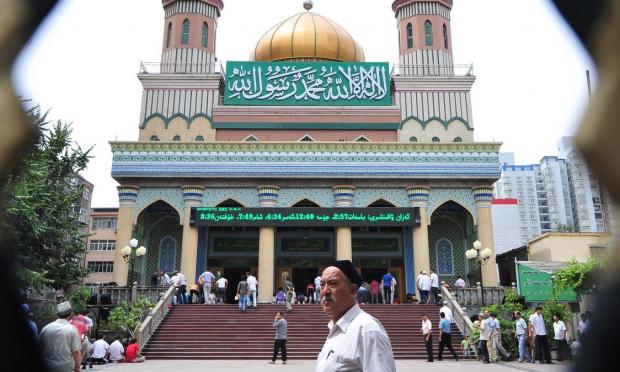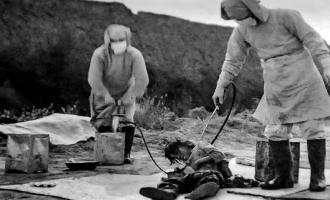The Jiaman Mosque in the city of Qira, in China’s far western region of Xinjiang, hides behind high walls and communist party propaganda posters, leaving passersby without any indication that it is home to a religious site.
In late April, during the Muslim holy month of Ramadan, two ethnic Uyghur women sat behind a small mesh rack under a surveillance camera inside the compound of what had long been the place of worship. largest in town.
Reuters could not establish whether the site was currently functioning as a mosque. Within minutes of the reporters’ arrival, four plainclothes men appeared and took up positions around the site, closing the doors of nearby residential buildings.
The men told reporters that it was illegal to take photos and leave. “There is no mosque here … there has never been a mosque on this site,” one of the men said in response to a Reuters question whether there was a mosque inside. He refused to identify himself.
The minarets at the four corners of the building, visible in publicly available satellite images in 2019, have disappeared. There was a large blue metal box where the central dome of the mosque had once stood. It was unclear if it was a place of worship at the time the satellite images were taken.
In recent months, China has stepped up a campaign in state media and with government-organized tours to counter criticism from researchers, human rights groups and former Xinjiang residents who say thousands of mosques they have been the target of an offensive against the Uighur population, mostly Muslim, in the region.
Officials from Xinjiang and Beijing told reporters in Beijing that no religious sites had been forcibly destroyed or restricted and invited them to visit and report. “Instead, we have taken a series of measures to protect them,” Elijan Anayat, a Xinjiang government spokesman, said of the mosques late last year.
Foreign Ministry spokeswoman Hua Chunying said on Wednesday that some mosques had been demolished, while others had been improved and expanded as part of rural revitalization, but that Muslims could practice their religion openly at home and in the villages. mosques. When asked about the restrictions imposed by the authorities on journalists visiting the area, Hua said reporters should do more to “win the trust of the Chinese people” and report objectively.
Reuters visited more than two dozen mosques in seven counties in southwestern and central Xinjiang in a 12-day visit during Ramadan, which ended on Thursday.
There is a contrast between Beijing’s campaign to protect mosques and religious freedom and the reality on the ground. Most of the mosques that Reuters visited had been partially or completely demolished.
‘Life is Beautiful’
China has repeatedly said that Xinjiang faces a serious threat from separatists and religious extremists who plan attacks and provoke tensions between Uyghurs who call the region home and the Han ethnic group, China’s largest ethnic group.
A massive crackdown that includes a campaign to restrict religious practice and what rights groups describe as the forced political indoctrination of more than a million Uyghurs and other Muslims began in earnest in 2017. China initially denied having detained people in detention camps, but has since said that they are vocational training centers and that people have “graduated” from them.
The government says there are more than 20,000 mosques in Xinjiang, but no detailed data on their status is available. Some functioning mosques have signs saying that parishioners must register, while citizens from outside the area, foreigners and anyone under the age of 18 are prohibited from entering.
The mosques in operation have surveillance cameras and include Chinese flags and propaganda displays declaring allegiance to the ruling Communist Party. Visiting reporters were almost always followed by plainclothes personnel and warned not to take photographs. A Han woman, who said she had moved to Hotan City six years ago from central China, said Muslims who wanted to pray could do so at home.
“There are no Muslims like this here anymore,” the woman said, referring to those who used to pray in the mosque. She added: “Life in Xinjiang is beautiful.”
‘Ethnic unity’
Some state-sanctioned mosques are shown to visiting journalists and diplomats, such as the Jiaman Mosque in Hotan. “Everything is paid for by the party,” said a Hotan official at the mosque on a visit organized for Reuters by the city’s propaganda department.
The official, who called himself “Ade” but refused to give his full name, said the men were free to pray in the mosque five times a day, according to Islamic custom. While the reporters were there, several dozen men, most of them elderly, came to pray at dusk. Subsequently, they broke their fast with food provided by the local government.
The more than 170-year-old mosque is one of four in the region reserved as cultural relics, with funding for central government renewal, the Xinjiang government said. As the mosque leader or imam took off their shoes, Ade demonstrated a machine provided by the government that wraps shoes in plastic.
“Now you don’t even need to take your shoes off in the mosque, it’s very convenient,” he said.
Crumbling minarets
In Changji, about 40 km west of the regional capital, Urumqi, the green and red minarets of the city’s Xinqu Mosque lay broken beneath a Chinese flag that fluttered over the courtyard of the deserted building. Reuters analyzed satellite images of 10 mosques in the city of Changji and visited six of them.
A total of 31 minarets and 12 green or gold domes were removed in a two-month period after April 2018, according to dated images. In several mosques, Islamic architecture was replaced by Chinese-style roofs. These included Changji’s Tianchi Road Mosque, whose golden dome and minarets were removed in 2018, according to publicly available satellite images.
The Xinjiang government did not respond to a request for comment on the state of mosques in the region. Researchers from Australian Institute of Strategic Policy It is estimated in 2020, after a survey of 900 Xinjiang locations, that 16,000 mosques had been partially or totally destroyed during the previous three years. Signs outside the Xinqu Mosque, with the demolished minarets, said that a housing development would soon be built on the site.

Κόσμος
Ενημερώθηκε στις:
Mosques disappear as China strives to ‘build a beautiful Xinjiang’

Ακολουθήστε το Πενταπόσταγμα στο Google news













